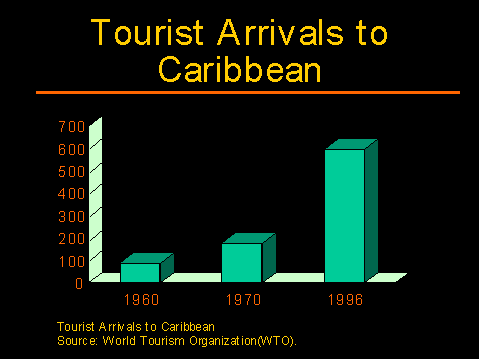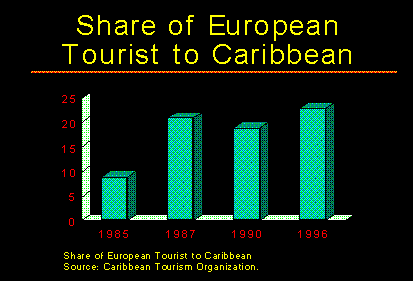 BATE Professor
Wayne Hayes, Ph.D., May 30,
2000
BATE Professor
Wayne Hayes, Ph.D., May 30,
2000Ecotourism by Dina Fried, David Nenner, Heather Triano
 BATE Professor
Wayne Hayes, Ph.D., May 30,
2000
BATE Professor
Wayne Hayes, Ph.D., May 30,
2000
Ecotourism by Dina Fried, David Nenner,
Heather Triano
The definition of ecotourism, as defined by Marta Honey, author of "Ecotourism and Sustainable Development" is, "The basic premise for ecotourism is to be used as an instrument to partake in rural economic development and ecological conservation." The objective is to create a win-win situation for the environment, local communities, and the tourists.
Both the cruise line industry and Caribbean nations have a vested interest in protecting the environment. The beautiful locations, pristine beaches and tranquil garden settings attract customers to various locations, and customers turn into money.

The World Tourism Organization has published statistics on the growth of the tourism in the Caribbean:

Travel growth to the Caribbean has scene a steady increase. Travel slumps were attributed to Oil Crisis during the 1980’s and again in 1991 with the Persian Gulf War. WWW. cha-cast.com/tourism.htm. European travelers comprise a large part of the Caribbean tourist industry. They account for "higher share of the total bed nights spent by tourist in the region than their numbers would suggest."
Paul Hawken author of The Ecology of Commerce offers extensive analysis of business and the environment. "Business practiced today is the opposite of careful footsteps demanded of the stones, stones that make us conscious of each moment on the path, an arrangement that allows us to stop and consider the environment around us rather than merely walking or rushing through. A careful, attentive path corresponds to an ecological sense of time, honoring all biological connections."
At first glance we connate cruises with relaxation, exotic destinations and leisure. We think of extravagant smorgasbord and shuffleboard. However, cruise lines are more than a buffet they are a major economic force and potential environmental hazard to the ports and the waters they visit.
Cruise ship tourism is proclaimed by the seas trade industry to be a benefit for the Caribbean, however the way in which it happens is another question. Caribbean tourism associations are projecting better than ever trends in the cruise passenger arrivals. The increased interest in tourism is directly impacting the environment; garbage is mounting on the sea floors, harbor areas, ports and water pollution etc.
Cruise vessel embarkations from North American ports from 1991 through 1997 have increased by almost fifty percent. Global capacity has also increased by the same amount. The top cruise destination markets are the Caribbean, Alaska, the Mediterranean, Europe, Trans-Canal (Panama), Mexico and Bermuda.
| Number of N.A. passenger boardings | 5.5 million |
| Number of Worldwide passenger boardings
Represents a 73% since 1990 |
9 million |
| Number of vessels embarking from N.A. | 131 |
Source: International Council of Cruise Lines.
As we can see the cruise industry has experienced colossal growth in this decade. The number of passengers taking a cruise has increased 8.5% per year since 1990.(The Economist) Based upon an analysis of the industry’s historical growth performance, PricewaterhouseCoopers (PwC) and Wharton Economic Forecasting Associates (WEFA) conducted a forecast of projected growth for the North American cruise industry from 1998 through 2002. The forecast resulted in projected capacity growth of 43% by 2002.
According to Mary B. Uebersax, "the island nations of the Caribbean Nations the benefits of the expanding industry may be in opposition with their overall development objectives." The islands environmental majestic beauty is a primary commodity for supplementing their local economies. The financial impacts aren’t just lucrative but sum over 7 billion dollars annually in the tourism industry.
Cruise ships are effecting the environment in the following areas:
The increased growth of the industry has not only impacted itself but has had major impacts on other U.S. industry as well as the Caribbean.
|
$6.6 billion | |
|
$11.6 billion |
|
176,433 US jobs | |
|
||
|
The top five U.S industries impacted by the cruise line industry are:
The travel and tourism industry in the Caribbean region is vital to the Caribbean‘s infrastructure, people and their communities. The economy of the Caribbean receives many benefits from the cruise line industry, providing 10.7 of the 24.54 million visitors to the Caribbean in 1996, a 10.9% increase from 1995. (WWW.cha-cast.com/tourism.htm)
Cruise lines are striving to improve waste disposal management. Holland America Line (HAL) has made great strides in improving waste disposal management. Each ship generates approximately eight tons of refuse, on average, during a seven-day cruise. Each ship is equipped with various types of processing equipment, such as a mulcher, grinder, glass breaker, densifier, baler and/or incinerator. The waste is carefully separated and processed Waste is processed for onboard storage for land disposal or recycling. Glass is ground into small fragments; paper is baled or burned. Food waste is either, mulched and dumped or saved for shore disposal, depending on where the ship is, and all plastic is saved for shore disposal.
The chief of environmental programs at HAL, Randall Peterson, makes an admirable imprint when he says, "All of our environmental efforts are focused on standard operating procedures that hold the environment in the highest esteem so that we have the smallest impact possible on our resource. We continually review our products that we buy to ensure that they are environmentally safe and non-hazardous to crews and passengers. We also include training as a high priority in the correct and safe use of all products." (WWW.cruiseindustrynews.com/wastedisposal.html)
Although, there has been a great deal of negative publicity for these cruise ships with regard to their attitude towards the environment, they are attempting projects in order to correct the past behavior. Just about the entire cruise line industry is becoming more and more aware of the passenger interest in the environment. As stated above by Randall Peterson, they can not afford to damage the ocean environment, since that is the main resource to their success in the business.
Esteemed marine environmentalist Jean Michel Cousteau, wrote for Porthole Magazine, "What Cruising Can Give Back to the Oceans", in the June 1998 issue. He affirms that today’s cruise passenger is more aware of the ocean environment around them. These passengers are willing to pay a little more to ensure against destroying the oceans. Cousteau makes several suggestions that can be taken by the cruise lines as well as the passengers to allow for cleaner seas. Some of these suggestions are:
With much concern from the Cruise lines, Coast Guard, International Maritime Organization, New Jersey Sea Grant Marine Advisory Service, World Bank, Center for Marine Conservation, etc., cruise lines are reducing their garbage. They have made successful progress, as displayed at an anti-pollution seminar recently. One official told hundreds of attendants that in a one-day clean-up-the-coast campaign, not a single item, which could be traced to a cruise ship, could be found. Much of the success in eliminating pollution is due to U.S. and international laws enforced along U.S. shorelines by the Coast Guard, along with pressure from the passengers. (WWW.sptimes.com/Travel97/10198/Cruise_Lines_Reducing.html)
Our next discussion, Maritime Law, is followed by a case study of the Royal Caribbean Cruise Line.
![]()
©Dina Fried, David Nenner,
Heather Triano, Jenine Verdina
Business and the Environment, Summer, 1999
whayes@orion.ramapo.edu
June
30, 1999 05:43:01 PM